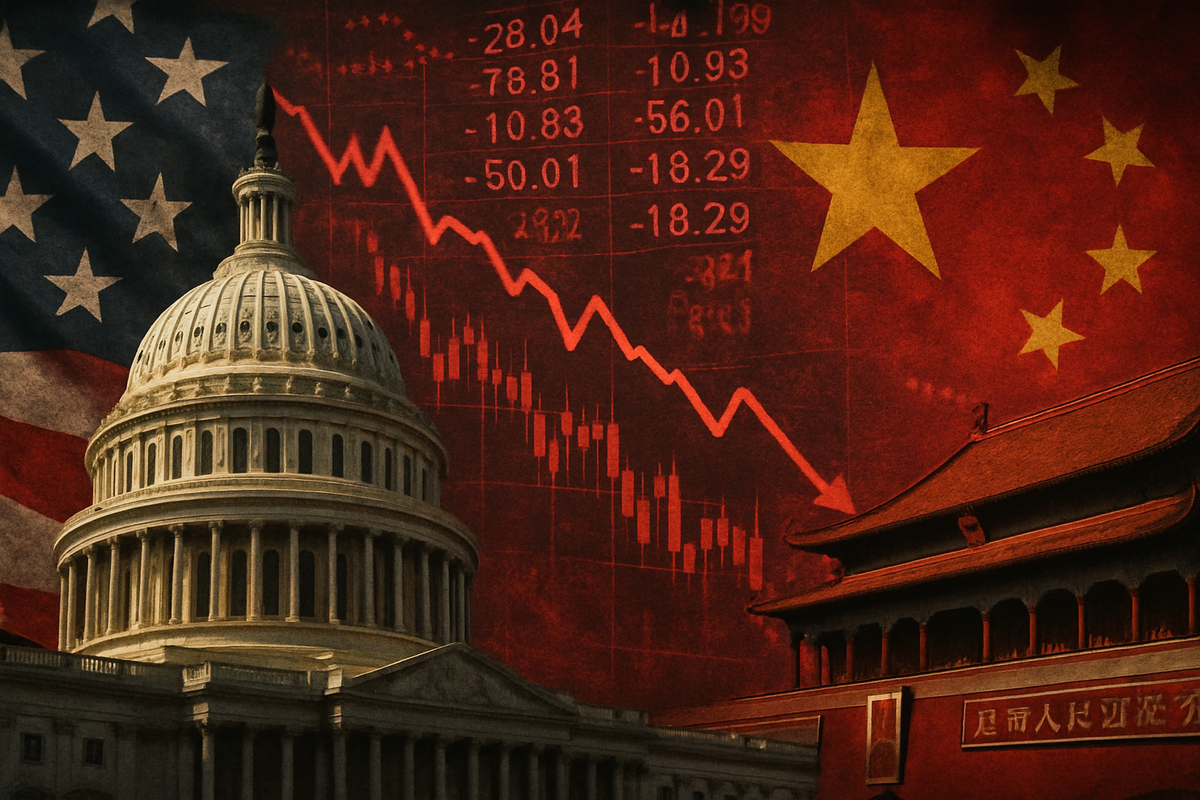US-China Trade Tensions Reignite, Triggering Global Market Sell-Off

Global financial markets were gripped by a sharp sell-off this week, as renewed trade tensions between the United States and China escalated dramatically, threatening to plunge the world's two largest economies into a full-blown trade war. The immediate trigger was a series of reciprocal tariff announcements and export restrictions, which sent shivers through investor confidence and erased significant gains across major indices.
The escalation, coming just weeks before a critical trade truce deadline, has cast a long shadow over global economic stability. Investors are grappling with the potential for disrupted supply chains, increased business costs, and a slowdown in international trade, leading to a flight to safe-haven assets and a significant repricing of risk across equities.
A Rapid Escalation of Economic Hostilities
The latest round of hostilities began on October 9, 2025, when China's Ministry of Commerce (MOFCOM) announced sweeping new export restrictions on various rare earths, related production equipment, materials, and technologies, citing national security. These controls, which also included crucial components like Lithium-ion batteries and synthetic graphite anodes, were set to come into effect immediately for technologies and by November 8 for other materials. Concurrently, China added 14 foreign entities to its "unreliable entities" list, signaling a more assertive stance.
The United States was quick to respond. On October 10, 2025, President Donald Trump announced that the U.S. would impose an additional 100% tariff on Chinese imports, layered "over and above any Tariff that they are currently paying," effective November 1. This aggressive move was coupled with a threat of new U.S. export controls on "any and all critical software," directly targeting China's technological ambitions. The announcement immediately sent shockwaves through global markets, interrupting a rally that had seen the S&P 500 Index increase by over 15% year-to-date.
China retaliated swiftly on October 14, 2025, mirroring U.S. actions by imposing new port fees on U.S.-owned, operated, and built vessels. Furthermore, Beijing sanctioned five U.S.-associated subsidiaries of the South Korean shipbuilder Hanwha Ocean, directly countering American restrictions on its shipping sector. The tit-for-tat measures have cemented fears of a prolonged economic conflict.
The market's reaction was immediate and severe. On Friday, October 10, the S&P 500 Index dropped 182.6 points (2.7%) to 6,552, marking its largest one-day point and percentage decline since April. Asian markets followed suit on Monday, October 13, with Hong Kong's Hang Seng Index falling 3.6% and China's Shanghai Composite Index shedding 2.5%. By Tuesday, October 14, U.S. equity futures continued to pull back, and markets opened lower, with the S&P 500 down 1.3%, the Dow Jones Industrial Average losing 1.1%, and the Nasdaq Composite dropping 1.9%. Investors flocked to safe-haven assets, with bond yields falling and gold prices surging to new record highs, exceeding $4,100 per ounce.
Companies Navigating the Crosscurrents
The renewed trade tensions are creating clear winners and losers across various sectors. Companies heavily reliant on global supply chains, particularly those with significant exposure to both U.S. and Chinese markets, are bracing for impact.
On the losing side, technology and manufacturing sectors are particularly vulnerable. Chipmakers like Micron Technology (NASDAQ: MU), Intel (NASDAQ: INTC), ON Semiconductor (NASDAQ: ON), and Nvidia (NASDAQ: NVDA) saw their shares fall between 2% and 4% following the announcements. These companies face the dual threat of increased tariffs on components imported from China and potential export controls on their critical software and hardware to the Chinese market, which represents a significant portion of their revenue. Other manufacturing giants with extensive operations in China, such as Apple Inc. (NASDAQ: AAPL) and Tesla Inc. (NASDAQ: TSLA), could see their production costs rise and sales in China impacted by retaliatory measures or consumer sentiment shifts.
Conversely, companies involved in the extraction and processing of rare earth minerals are experiencing a surge. China's export restrictions on these critical materials have highlighted their strategic importance, leading to sharp gains for Western rare earth producers. Companies such as Critical Metals (NASDAQ: CRML), USA Rare Earth, and MP Materials (NYSE: MP) have seen their stock prices climb as investors anticipate increased demand and higher prices for non-Chinese sources. These companies are now seen as crucial players in diversifying global supply chains away from China's dominance, potentially benefiting from government incentives and strategic investments aimed at securing these vital resources.
Broader Implications and Historical Parallels
This latest flare-up in U.S.-China trade relations is more than just a tariff dispute; it's a critical inflection point in the broader trend of economic decoupling and strategic rivalry. It underscores the ongoing shift from a globally integrated economy towards a more fragmented, bloc-oriented system, driven by national security concerns and technological supremacy. The event fits squarely into the narrative of nations seeking to secure critical supply chains and reduce dependencies on geopolitical rivals.
The ripple effects extend beyond direct trade. Competitors and partners of U.S. and Chinese firms are now forced to re-evaluate their own sourcing and sales strategies. Companies in allied nations may face pressure to choose sides or diversify their own supply chains to avoid being caught in the crossfire. Regulatory and policy implications are significant, with governments likely to introduce more stringent export controls, import restrictions, and subsidies for domestic industries deemed critical. This could accelerate the "reshoring" or "friend-shoring" of manufacturing capabilities, particularly in high-tech and strategic sectors.
Historically, trade wars have rarely produced clear winners, often leading to higher costs for consumers, reduced economic growth, and increased market volatility. Comparisons can be drawn to the U.S.-China trade war initiated in 2018, which saw similar tariff escalations and market downturns. However, the current situation appears more entrenched, with both nations framing their actions in terms of national security and technological dominance rather than purely economic terms, suggesting a deeper and potentially more intractable conflict.
What Comes Next: A Precarious Path Forward
The immediate future hinges precariously on the upcoming November 10, 2025, deadline for a broader trade deal. While President Trump offered a conciliatory message on social media on October 12, stating, "Don't worry about China, it will all be fine!", and China's Ministry of Commerce reiterated a willingness for dialogue, the underlying tensions remain.
In the short term, markets will likely remain volatile, reacting to every statement and policy announcement from Washington and Beijing. Investors should brace for continued uncertainty and potential further sell-offs if the rhetoric hardens or if the November 10 deadline passes without a resolution. Companies will need to accelerate their strategic pivots, exploring alternative sourcing locations, diversifying manufacturing bases, and re-evaluating market priorities to mitigate risks.
Long-term possibilities include a sustained period of economic nationalism and protectionism, leading to a more fragmented global economy. This could create new market opportunities for countries and companies outside the immediate U.S.-China orbit, particularly those that can offer stable and diversified supply chain solutions. Conversely, it poses significant challenges for multinational corporations that have thrived on globalization. Potential scenarios range from a gradual de-escalation through renewed negotiations to a prolonged "tech cold war" that reshapes global trade and technological landscapes for decades.
Comprehensive Wrap-Up: Navigating a New Economic Reality
The latest surge in U.S.-China trade tensions serves as a stark reminder of the fragile state of global economic relations. The key takeaways are clear: national security concerns are increasingly driving economic policy, supply chain resilience is paramount, and the era of unfettered globalization is facing significant headwinds.
Moving forward, the market will remain highly sensitive to geopolitical developments. Investors should closely monitor diplomatic overtures, new policy announcements, and the performance of sectors directly impacted by tariffs and export controls. The actions of key players like the U.S. Treasury, Commerce Department, and China's MOFCOM will be critical in shaping the trajectory of this conflict.
The lasting impact could be a fundamental restructuring of global trade, with a greater emphasis on regional blocs and diversified sourcing. Companies that can adapt quickly, build resilient supply chains, and navigate complex regulatory environments will be best positioned to succeed. For investors, vigilance, diversification, and a deep understanding of geopolitical risks will be essential in the coming months and years.
This content is intended for informational purposes only and is not financial advice
More News
View More




Recent Quotes
View More
Quotes delayed at least 20 minutes.
By accessing this page, you agree to the Privacy Policy and Terms Of Service.